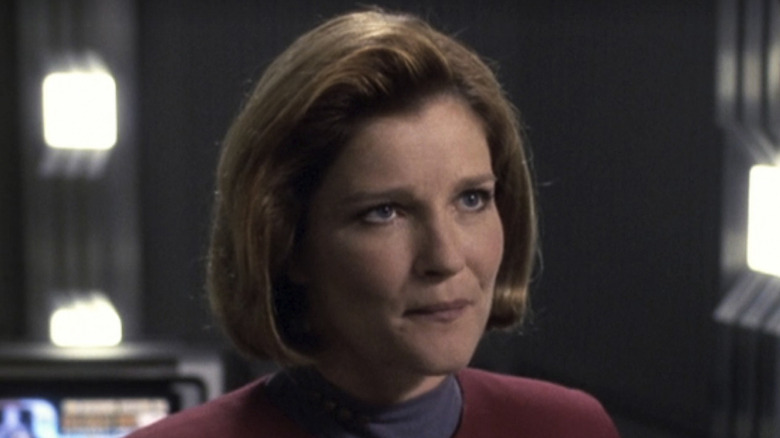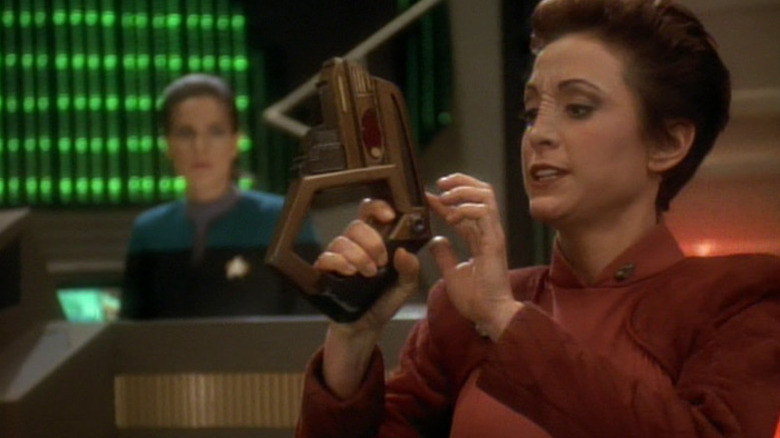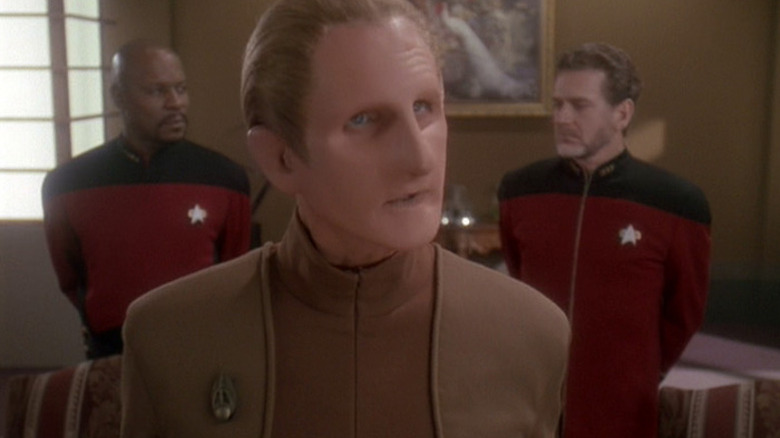Voyager's Debut Had A Positive Effect On Star Trek: DS9's Storytelling Approach
In 1993, "Star Trek: The Next Generation" was working its way through a sixth blockbuster season when "Star Trek: Deep Space Nine" debuted as a tonal counterpart. "Next Generation," set on a fast-moving starship, was an optimistic show about exploration and diplomacy. "Deep Space Nine," meanwhile, was set on a station where capitalism was still in place and a nearby world was recovering from a brutal military occupation. "TNG" was about a scientific utopia. "Deep Space Nine" got its hands dirty with politics, money, and religion.
"TNG" concluded in May of 1994, leaving "Deep Space Nine" as the only "Star Trek" series on the air for a spell. From May to January, "Deep Space Nine" held its own for a solid 14 episodes. During that time, the series was clearly trying to move into a serialized structure. The DS9 writers knew their political stories warranted a longer-form format, but Paramount insisted that the show remain as episodic as possible, wanting it to be syndication-friendly (single episodes are easier to sell as reruns).
In January of 1995, "Star Trek: Voyager" debuted, and it was another series set on a fast-moving starship. This time, the ship was lost 70 years away from Earth. Also like "TNG," the premise of "Voyager" was friendlier to episodic storytelling, and the writers stuck to that structure through all seven seasons. Because Paramount was getting what they wanted (structure-wise) from "Voyager," the "Deep Space Nine" writers were being merrily overlooked. The DS9 showrunners could suddenly begin writing the long-form political stories they always wanted, with "Voyager" deflecting any criticism from the higher-ups.
DS9 showrunner Ira Steven Behr, along with writer Ron D. Moore, spoke with Syfy in 2018 to discuss the sea change that their series experienced in 1995.
While Paramount was looking at Voyager, the Deep Space Nine writers got to play
Behr recalled the pushback he got from Paramount, hearing in clear terms that the studio wanted single episodes like "TNG." That series, after all, was enormously successful, and Paramount wanted to replicate that success. Behr had to explain multiple times that "Deep Space Nine" was a different animal, mostly because of its location. Since Deep Space Nine was a space station, the main characters would experience consequences in a different way than those of other shows. In Behr's words:
"Everyone was against any form of serialization and continuing storylines. It was basically, 'You're killing the show. The audience can't follow from week to week. We want TNG type episodes, self-sustained episodes where the story is summed up and completed in one episode, and then they go off to another adventure.' We kept saying they're not going off anywhere. That's the cool thing and the different thing about this show. They're a space station. Every decision they make will haunt them one way or the other because they're going to stay there, so it was not pretty in lots of ways."
He was sure to add, however: "Thank God 'Voyager' came on, and they left us alone."
Fans of "Deep Space Nine" will be able to see a palpable shift beginning in the 1995 season of the series. "Voyager" was the new baby of the "Star Trek" family, and a lot of energy and publicity went into producing that series. And if Paramount was spreading themselves thin with the new baby, then the irascible middle child could get away with naughtier things. In an era before DVRs and streaming, "Deep Space Nine" started doing longer-form narratives with a much larger cast. Many say the show greatly improved.
Ronald D. Moore liked the post-Voyager freedom
Ronald D. Moore, one of the chief writers of '90s-era "Star Trek" shows, also remembers the pushback he and his team got from Paramount. The studio, whether correct or incorrect, felt that audiences would only be able to catch random episodes of a TV series in any possible order, freeing them of sticking to a viewing schedule. That practice wouldn't be possible if every episode linked to the one that came before it. Again, this was before the proliferation of streaming or owning TV shows on DVD.
Moore, however, wanted "Deep Space Nine" to be more ambitious than the "catch random episodes" practice would allow. Moore said that he and the staff sneakily began expanding the narratives so that they looked episodic, but were really serialized. And then, once "Voyager" came along, he didn't have to pretend anymore. In his words:
"[W]hether you liked it or not, the station wasn't going anywhere, so all the stories you dealt with last week were pretty much going to be there the following week. What started to happen was, bit by bit, we just kept sneaking in more and more continuing stories and Paramount kept resisting and trying to push back and make us do more standalone stuff, but eventually they just kind of threw up their hands and said, 'Whatever, we're concentrating on "Voyager" now.' By end of the show, the last couple of seasons, it was almost all straight-up serial."
Also, by the end of "Deep Space Nine" in 1999, the series had close to 30 main characters and a full-blown galactic war. It wasn't the peace-loving utopia of the previous "Star Trek" shows, but it was morally intriguing. It remains the most complex and ambitious of the "Star Trek" shows.


